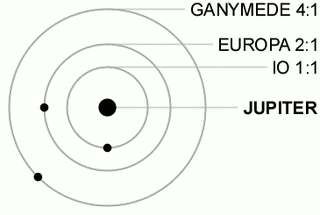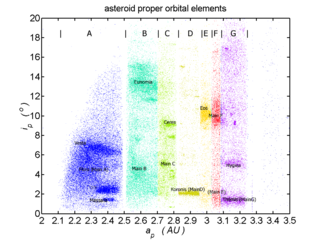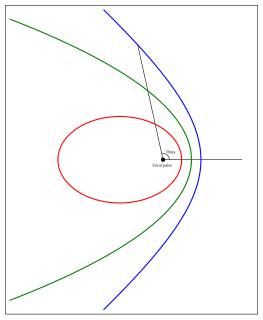
In celestial mechanics, an orbital resonance occurs when orbiting bodies exert a regular, periodic gravitational influence on each other, usually because their orbital periods are related by a ratio of small integers. Most commonly this relationship is found for a pair of objects. The physical principle behind orbital resonance is similar in concept to pushing a child on a swing, where the orbit and the swing both have a natural frequency, and the other body doing the "pushing" will act in periodic repetition to have a cumulative effect on the motion. Orbital resonances greatly enhance the mutual gravitational influence of the bodies, i.e., their ability to alter or constrain each other's orbits. In most cases, this results in an unstable interaction, in which the bodies exchange momentum and shift orbits until the resonance no longer exists. Under some circumstances, a resonant system can be stable and self-correcting, so that the bodies remain in resonance. Examples are the 1:2:4 resonance of Jupiter's moons Ganymede, Europa and Io, and the 2:3 resonance between Pluto and Neptune. Unstable resonances with Saturn's inner moons give rise to gaps in the rings of Saturn. The special case of 1:1 resonance between bodies with similar orbital radii causes large Solar System bodies to eject most other bodies sharing their orbits; this is part of the much more extensive process of clearing the neighbourhood, an effect that is used in the current definition of a planet.

An asteroid family is a population of asteroids that share similar proper orbital elements, such as semimajor axis, eccentricity, and orbital inclination. The members of the families are thought to be fragments of past asteroid collisions. An asteroid family is a more specific term than asteroid group whose members, while sharing some broad orbital characteristics, may be otherwise unrelated to each other.
The Eos family is a very large asteroid family located in the outer region of the asteroid belt. The family of K-type asteroids is believed to have formed as a result of an ancient catastrophic collision. The family's parent body is the asteroid 221 Eos.
Hungaria is a relatively small asteroid orbiting in the inner asteroid belt. It is an E-type (high-albedo) asteroid. It is the namesake of the Hungaria asteroids, which orbit the Sun on the inside of the 1:4 Kirkwood gap, standing out of the core of the asteroid belt.
677 Aaltje is a main-belt minor planet orbiting the Sun, discovered by August Kopff at Heidelberg on January 18, 1909. It was named after the Dutch singer Aaltje Noordewier-Reddingius.
The Massalia family is a family of asteroids in the inner asteroid belt, named after its parent body, 20 Massalia. It consists of S-type asteroids with very low inclinations, straddling the 1:2 resonances with Mars. There are more than 6,000 known Massalian asteroids.
A Hecuba-gap asteroid is a member of a dynamical group of resonant asteroids located in the Hecuba gap at 3.27 AU – one of the largest Kirkwood gaps in the asteroid belt, which is considered the borderline separating the outer main belt asteroids from the Cybeles. A Hecuba-gap asteroid stays in a 2:1 mean motion resonance with the gas giant Jupiter, which may gradually perturbe its orbits over a long period until it either intersect with the orbit of Mars or Jupiter itself. Depending on the dynamical stability of an asteroid's orbit in the Hecuba gap, three subgroups have been proposed. These are the marginally unstable Griqua asteroids, with an estimated lifetime of more than 100 million years, the stable Zhongguo asteroids, and an unnamed, strongly unstable population of asteroids with a dynamical lifetime of less than 70 million years.

7604 Kridsadaporn, provisional designation 1995 QY2, is an unusual, carbonaceous asteroid and Mars-crosser on a highly eccentric orbit from the outer regions of the asteroid belt, approximately 12 kilometers (7.5 miles) in diameter. It was discovered on 31 August 1995, by Australian astronomer Robert McNaught at Siding Spring Observatory near Coonabarabran, Australia. Due to its particular orbit, the C-type asteroid belongs to MPC's list of "other" unusual objects, and has been classified as an "asteroid in cometary orbit", or ACO. The asteroid was named in memory of Thai astronomer Kridsadaporn Ritsmitchai.
2169 Taiwan, provisional designation 1964 VP1, is a carbonaceous Astridian asteroid from the central regions of the asteroid belt, approximately 17 kilometers in diameter. It was discovered on 9 November 1964, by astronomers at the Purple Mountain Observatory near Nanking, China. It was named for Taiwan.

The Nicemodel is a scenario for the dynamical evolution of the Solar System. It is named for the location of the Observatoire de la Côte d'Azur, where it was initially developed, in 2005 in Nice, France. It proposes the migration of the giant planets from an initial compact configuration into their present positions, long after the dissipation of the initial protoplanetary disk. In this way, it differs from earlier models of the Solar System's formation. This planetary migration is used in dynamical simulations of the Solar System to explain historical events including the Late Heavy Bombardment of the inner Solar System, the formation of the Oort cloud, and the existence of populations of small Solar System bodies including the Kuiper belt, the Neptune and Jupiter trojans, and the numerous resonant trans-Neptunian objects dominated by Neptune. Its success at reproducing many of the observed features of the Solar System means that it is widely accepted as the current most realistic model of the Solar System's early evolution, although it is not universally favoured among planetary scientists. Later research revealed a number of differences between the original Nice model's predictions and observations of the current Solar System, for example the orbits of the terrestrial planets and the asteroids, leading to its modification.
5477 Holmes, provisional designation 1989 UH2, is a Hungaria asteroid and binary system from the innermost regions of the asteroid belt, approximately 3 kilometers (2 miles) in diameter. It was discovered on 27 October 1989, by American astronomer Eleanor Helin at the Palomar Observatory in California. The presumed E-type asteroid is likely spherical in shape and has a short rotation period of 2.99 hours. It was named for American amateur astronomer Robert Holmes. The discovery of its 1-kilometer-sized minor-planet moon was announced in November 2005.

The Late Heavy Bombardment is an event thought to have occurred approximately 4.1 to 3.8 billion years (Ga) ago, at a time corresponding to the Neohadean and Eoarchean eras on Earth. During this interval, a disproportionately large number of asteroids are theorized to have collided with the early terrestrial planets in the inner Solar System, including Mercury, Venus, Earth, and Mars.
The five-planet Nice model is a recent variation of the Nice model that begins with five giant planets, the current four plus an additional ice giant, in a chain of mean-motion resonances. After the resonance chain is broken, the five giant planets undergo a period of planetesimal-driven migration, followed by an instability with gravitational encounters between planets similar to that in the original Nice model. During the instability the additional giant planet is scattered inward onto a Jupiter-crossing orbit and is ejected from the Solar System following an encounter with Jupiter. An early Solar System with five giant planets was proposed in 2011 after numerical models indicated that this is more likely to reproduce the current Solar System.

The E-belt asteroids were the population of a hypothetical extension of the primordial asteroid belt proposed as the source of most of the basin-forming lunar impacts during the Late Heavy Bombardment.
The jumping-Jupiter scenario specifies an evolution of giant-planet migration described by the Nice model, in which an ice giant is scattered inward by Saturn and outward by Jupiter, causing their semi-major axes to jump, quickly separating their orbits. The jumping-Jupiter scenario was proposed by Ramon Brasser, Alessandro Morbidelli, Rodney Gomes, Kleomenis Tsiganis, and Harold Levison after their studies revealed that the smooth divergent migration of Jupiter and Saturn resulted in an inner Solar System significantly different from the current Solar System. The sweeping of secular resonances through the inner Solar System during the migration excited the orbits of the terrestrial planets, leaving them too eccentric, and left the asteroid belt with too many high-inclination objects. The jumps in the semi-major axes of Jupiter and Saturn described in the jumping-Jupiter scenario can allow these resonances to quickly cross the inner Solar System without altering orbits excessively, although the terrestrial planets remain sensitive to its passage. The jumping-Jupiter scenario also results in a number of other differences with the original Nice model. The fraction of lunar impactors from the core of the asteroid belt during the Late Heavy Bombardment is significantly reduced, most of the Jupiter trojans are captured during Jupiter's encounters with the ice giant, as are Jupiter's irregular satellites. In the jumping-Jupiter scenario, the likelihood of preserving four giant planets on orbits resembling their current ones appears to increase if the early Solar System originally contained an additional ice giant, which was later ejected by Jupiter into interstellar space. However, this remains an atypical result, as is the preservation of the current orbits of the terrestrial planets.

In planetary astronomy, the grand tack hypothesis proposes that after its formation at 3.5 AU, Jupiter migrated inward to 1.5 AU, before reversing course due to capturing Saturn in an orbital resonance, eventually halting near its current orbit at 5.2 AU. The reversal of Jupiter's migration is likened to the path of a sailboat changing directions (tacking) as it travels against the wind.




















